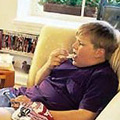 這個星期《社會科學與醫療》期刊在網路上刊登了一篇由華盛頓大學發表的研究,該研究發現鄰近地區的房價比起教育或收入,更能預測肥胖率。
這個星期《社會科學與醫療》期刊在網路上刊登了一篇由華盛頓大學發表的研究,該研究發現鄰近地區的房價比起教育或收入,更能預測肥胖率。
居住在最昂貴房子的人最不可能發生肥胖的現象。該研究發現在同一郵遞區號內,平均房價每增加10萬美元,肥胖率就下降2%。
地方的健康部門和聯邦所屬的疾病控制中心共同針對金郡(King County)居民做了電話訪問,根據電訪結果的分析發現,在西雅圖都會區,肥胖比率的差異高達6倍。
在最貧困的地區,肥胖率可達30%,而在最富有的郵遞區號地區,卻只有約5%的肥胖率。Adam Drewnowski博士為華盛頓大學肥胖研究中心的執行長,同時也是這份研究的主導人,他表示:「肥胖是一個經濟問題。了解肥胖在地理上的分佈將有助於我們找出最脆弱的區域。」
研究人員與當地名為「西雅圖與金郡公眾健康」(Public Health – Seattle & King County)的團體合作,從華盛頓州行為風險監督系統(Washington state's Behavioral Risk Factor Surveillance System, BRFSS)資料中,收集了超過8000份回覆民眾的跨年度資料。
住宅價格可視為郵遞區號這個社經狀態的代名詞。Drewnowski表示,「收入不等同於資產或財富。對美國人來說,最主要的財富資產是他們的房子。」
若某一區域是富裕的,則我們也可以預估該區的人可以獲得健康的食物,或者較多運動的機會。
華盛頓大學的研究是第一個以都會區為主,用貧窮或富裕的區域性差異為指標來調查肥胖率。該研究的結論是:在預測肥胖率時,社經程度差異的重要性,要比以往所認知的重要許多。
Neighborhood property values predict local obesity rates better than education or incomes, finds a study from the University of Washington published online this week by the journal "Social Science and Medicine."
People who live in the most expensive homes are least likely to be obsese. For each additional $100,000 in the median price of homes, the researchers found, obesity rates in a given ZIP code dropped by two percent.
Based on analyses of responses to a telephone survey conducted in King County by the local health department and the federal Centers for Disease Control, the study found six-fold disparities in obesity rates across the Seattle metropolitan area.
Obesity rates reached 30 percent in the most deprived areas but were only around five percent in the most affluent ZIP codes."Obesity is an economic issue," said Dr. Adam Drewnowski, director of the UW Center for Obesity Research and leader of the study. "Knowing more about the geography of obesity will allow us to identify the most vulnerable neighborhoods."
Working with the local health agency, Public Health-Seattle & King County, the researchers gathered multiple-year data from Washington state's Behavioral Risk Factor Surveillance System, BRFSS, for more than 8,000 respondents.
Residential property values were used as a proxy measure of ZIP code socioeconomic status. "Incomes are not the same as assets and wealth," said Drewnowski. "The chief financial asset for most Americans is their home."
Area prosperity can also be a good predictor of access to healthy foods, or opportunities for exercise.
The UW study was the first to examine obesity rates by area-based indexes of poverty and wealth across a metropolitan area.
The study concluded that social and economic disparities were more important in predicting obesity than previously thought.
全文及圖片詳見 ENS







